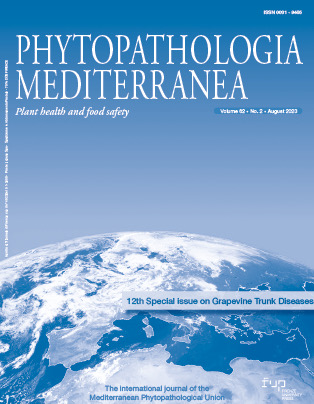Dual labelled probe assays for differentiation of Botryosphaeria dothidea, Neofusicoccum mediterraneum and Neofusicoccum parvum, based on polymorphisms in the MAT1-2-1 gene
Published 2023-07-23
Keywords
- diagnosis,
- mating type genes,
- molecular marker,
- real time PCR
How to Cite
Copyright (c) 2023 Stavros PALAVOUZIS, Alexandra TRIANTAFYLLOPOULOU, Christos TSOUKAS, Aliki K. TZIMA, Epaminondas PAPLOMATAS

This work is licensed under a Creative Commons Attribution 4.0 International License.
Funding data
-
European Social Fund
Grant numbers MIS 5048471
Abstract
Botryosphaeriaceous fungi are widespread, and cause serious diseases in many economically important crops. Botryosphaeria dothidea, Neofusicoccum mediterraneum and N. parvum are the most important members of this family in the Mediterranean region. These fungi are frequently isolated from the same host, which together with their extensive and increasing host range necessitates development of rapid and reliable diagnostic tools. Species boundaries within the Botryosphaeriaceae have been defined based on phylogenetic analyses of multiple gene sequences, including those of mating type genes. The MAT1-2-1 gene displayed high sequence variability between Botryosphaeriaceous species, so was selected as the target for development of a definitive diagnostic tool. This paper outlines a new and robust molecular tool, composed of three TaqMan assays based on polymorphisms located in the MAT1-2-1 gene of B. dothidea, N. mediterraneum and N. parvum. Each assay differentiated the target species from other Botryosphaeriaceae, and from non-target fungi.
Downloads
References
- Batista E., Lopes A., Alves A., 2020. Botryosphaeriaceae species on forest trees in Portugal: diversity, distribution and pathogenicity. European Journal of Plant Pathology 158: 693–720. https://doi.org/10.1007/s10658-020-02112-8 DOI: https://doi.org/10.1007/s10658-020-02112-8
- Chen S., Li G., Liu F., Michailides T.J., 2015. Novel species of Botryosphaeriaceae associated with shoot blight of pistachio. Mycologia 107: 780–792. https://doi.org/10.3852/14-242 DOI: https://doi.org/10.3852/14-242
- Chen S.F., Morgan D.P., Michailides T.J., 2014. Botryosphaeriaceae and Diaporthaceae associated with panicle and shoot blight of pistachio in California, USA. Fungal Diversity 67: 157–179. https://doi.org/10.1007/s13225-014-0285-6 DOI: https://doi.org/10.1007/s13225-014-0285-6
- Gusella G., Lawrence D.P., Aiello D., Luo Y., Polizzi G., Michailides T.J., 2021. Etiology of Botryosphaeria Panicle and Shoot Blight of Pistachio (Pistacia vera) Caused by Botryosphaeriaceae in Italy. Plant Disease 106: 1192–1202. https://doi.org/10.1094/PDIS-08-21-1672-RE DOI: https://doi.org/10.1094/PDIS-08-21-1672-RE
- Kumar S., Stecher G., Li M., Knyaz C., Tamura K., 2018. MEGA X: Molecular Evolutionary Genetics Analysis across Computing Platforms. Molecular Biology and Evolution 35: 1547–1549. https://doi.org/10.1093/molbev/msy096 DOI: https://doi.org/10.1093/molbev/msy096
- Lazzizera C., Frisullo S., Alves A., Phillips A.J.L., 2008. Morphology, phylogeny and pathogenicity of Botryosphaeria and Neofusicoccum species associated with drupe rot of olives in southern Italy. Plant Pathology 57: 948–956. https://doi.org/10.1111/j.1365-3059.2008.01842.x DOI: https://doi.org/10.1111/j.1365-3059.2008.01842.x
- Lopes A., Phillips A.J.L., Alves A., 2017. Mating type genes in the genus Neofusicoccum: Mating strategies and usefulness in species delimitation. Fungal Biology 121: 394–404. https://doi.org/10.1016/j.funbio.2016.08.011 DOI: https://doi.org/10.1016/j.funbio.2016.08.011
- Madeira F., Park Y. mi, Lee J., Buso N., Gur T., … Lopez R., 2019. The EMBL-EBI search and sequence analysis tools APIs in 2019. Nucleic Acids Research 47: W636–W641. https://doi.org/10.1093/nar/gkz268 DOI: https://doi.org/10.1093/nar/gkz268
- Marsberg A., Kemler M., Jami F., Nagel J.H., Postma-Smidt A., … Slippers B., 2017. Botryosphaeria dothidea: a latent pathogen of global importance to woody plant health. Molecular Plant Pathology 18: 477–488. https://doi.org/10.1111/mpp.12495 DOI: https://doi.org/10.1111/mpp.12495
- Palavouzis S., Triantafyllopoulou A., Tzima A.K., Paplomatas E.J., 2022. Differentiation between Botryosphaeria dothidea and Neofusicoccum spp. based on a single nucleotide polymorphism in the ITS region. Hellenic Plant Protection Journal 15: 49–56. https://doi.org/10.2478/hppj-2022-0006 DOI: https://doi.org/10.2478/hppj-2022-0006
- Pavlic D., Slippers B., Coutinho T.A., Wingfield M.J., 2009. Multiple gene genealogies and phenotypic data reveal cryptic species of the Botryosphaeriaceae: A case study on the Neofusicoccum parvum/N. ribis complex. Molecular Phylogenetics and Evolution 51: 259–268. https://doi.org/10.1016/j.ympev.2008.12.017 DOI: https://doi.org/10.1016/j.ympev.2008.12.017
- Ridgway H.J., Amponsah N.T., Brown D.S., Baskarathevan J., Jones E.E., Jaspers M. V, 2011. Detection of botryosphaeriaceous species in environmental samples using a multi-species primer pair. Plant Pathology 60: 1118–1127. https://doi.org/10.1111/j.1365-3059.2011.02474.x DOI: https://doi.org/10.1111/j.1365-3059.2011.02474.x
- Rumbos I., Rumbou A., 2001. Fungi associated with esca and young grapevine decline in Greece. Phytopathologia Mediterranea 40: 330–335. http://www.jstor.org/stable/44981638 DOI: https://doi.org/10.36253/phyto-4911
- Slippers B., Smit W.A., Crous P.W., Coutinho T.A., Wingfield B.D., Wingfield M.J., 2007. Taxonomy, phylogeny and identification of Botryosphaeriaceae associated with pome and stone fruit trees in South Africa and other regions of the world. Plant Pathology 56: 128–139. https://bsppjournals.onlinelibrary.wiley.com/doi/abs/10.1111/j.1365-3059.2006.01486.x DOI: https://doi.org/10.1111/j.1365-3059.2006.01486.x
- Stempien E., Goddard M.L., Wilhelm K., Tarnus C., Bertsch C., Chong J., 2017. Grapevine Botryosphaeria dieback fungi have specific aggressiveness factor repertory involved in wood decay and stilbene metabolization. PLoS ONE 12: 1–22. https://doi.org/10.1371/journal.pone.0188766 DOI: https://doi.org/10.1371/journal.pone.0188766
- Vakalounakis D.J., Ntougias S., Kavroulakis N., Protopapadakis E., 2019. Neofusicoccum parvum and Diaporthe foeniculina associated with twig and shoot blight and branch canker of citrus in Greece. Journal of Phytopathology 167: 527–537. https://eurekamag.com/research/070/937/070937956.php DOI: https://doi.org/10.1111/jph.12843






